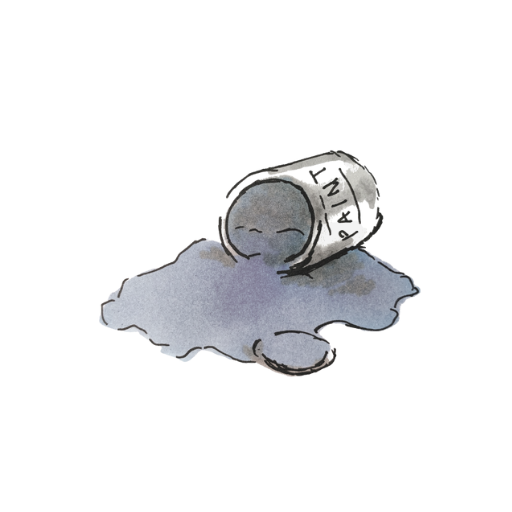
About a third of our already fairly small garden is occupied by a huge concrete slab. Shortly after we moved in in 2017, my dad suggested we could just paint the patio. I did exactly that and, considering I did no prep beyond a quick hose down, it held up pretty well for a few years. However, after some very wet winters, it had started to peel pretty badly and so I decided to have another go, but this time with all the prep.
Although my patio is a single block of concrete, this method can be applied to paving slabs as well. I will be painting our shady patio (which is paving slabs) soon using the same process. I will update the blog once I’ve finished that patio.


Kit you need to paint a patio
- Jet washer (you can rent them for the day)
- Stiff brush (not wire)
- Repair cement
- Masonry paint – I used Sandtex in Olive
- Possibly stabilising solution (I’ll come on to this)
- Possibly sealer (I’ll come on to this too)
- Paint brush
You can also get everything you need from Wickes or B&Q.
Managing Expectations…
Let’s be real here. Painting a patio is not going to be a long term solution. A concrete patio may pool water, you’ll be walking on it, probably getting it muddy gardening, playing football – whatever – it’s going to take a pounding. The paint will not last forever and realistically I wouldn’t expect more than a few years out of it before some maintenance is required. If you want your patio to look really good long term, tile it.
With that in mind though, some attention to the prep will make the painted patio last longer.
Check the weather forecast. You will want about a week to complete this project. Ideally set aside a dry week to complete the project in one go (because the patio needs to be clean and relatively dust free – not easy outdoors!)
It’s important to paint the patio when it is completely dry. If the concrete or slabs are still holding some water when you paint it, it will be more likely to peel later down the line.
Prepare the Patio for Painting
So let’s take a moment to enjoy how this influencer’s garden looked before….

Clean
Clear the space and jet wash the patio well to remove dirt, moss and flaky paint. You might need to give it a bit of a scrub with a stuff brush. You should avoid using a wire brush as this will leave little particles that could rust through the paint. We used a Karcher Pressure Washer. You can also hire them for the day. For the sake of saving the planet, I would generally say avoid using pressure washers unless you absolutely need to .
Leave the patio to dry out fully. This will take a couple of days in warm weather.

Repair
Next fill any cracks and craters with a suitable external filler / cement. I used quick drying repair cement.

If your patio is paved, now would be the time repair the grout. I didn’t need to do this, but I will update the blog once I have painted the other patio, which will include doing this step.
Leave those areas to dry for the time specified on the product before moving on to the next step.
Prime
There are two ways to prime your concrete patio. You will either do a mist coat or you may need to use stabilising solution. Both methods prime the surface ready for your top coat of masonry paint.
I used a stabilising solution on the patio before painting because it still had a lot of flaky paint and dust on the surface. However, this should be your last resort.

Stabilising solution is a sort of PVA mix which seals up the patio. This could be problematic down the line as trapped water cannot evaporate and therefore it could lead to yet more peeling. It may feel like the belt and braces approach but you don’t need to fix something that isn’t broken. If you have a sound surface to start with – i.e. no peeling paint and no efflorescence – then you probably don’t need stabilising solution. Instead, you can prime with a mist coat.
A mist coat is a first coat of masonry paint mixed with water. If you paint straight onto a porous surface such as concrete, the concrete draws the water out of the paint, leaving a film on the surface which is likely to peel. Mixing the paint with water for the first coat allows the porous concrete to draw out the water and the paint to adhere properly to the surface.
There is no need to mist coat after using stabilising solution because the stabilising solution creates a non-porous surface (remember the point of a mist coat is to prepare a porous surface for paint) and acts as a primer itself.
Paint
I used Sandtex Ultra Smooth Masonry Paint and I am very happy with the results.I would recommend getting a few tester pots first if possible, as the colours tend to come up quite different to how they appear on the tin. I got these four from Wickes.

If I had a pound for every time someone told me to use a roller to paint that patio, I’d definitely have about £8. Don’t use a roller though. Use a brush. The result is better (I speak from experience first time round). I used a fence brush.

The concrete is not an even surface and you need to cover it really well with paint or you will be more likely to leave air bubbles which may peel (again, I speak from experience). I also found the coverage much better with a brush (experience).
I will be completely honest – I didn’t do a second coat. However I recommend you do so to get the best finish. I just ran out of steam and I know the patio only needs to last me a year or two.
Remember to allow yourself an exit route as you paint!

Seal
The jury is out on this. I could not find a single sealer that was described as suitable for use on a painted patio. There are dozens of patio sealers out there but they are all intended for bare – and importantly – porous tiles or concrete. I was also worried about it becoming very slippery.
Having read a lot of guides and blogs and packaging labels I decided not to seal the patio. The preparation seems to me to be the important bit – cleaning and priming. The masonry paint I used specifically states that sealing is not required.
Time will tell though and I will report back.
If you do decide to seal the patio, the best option I could find seemed to be this one from Wickes.
How the painted patio looks after a month
Finally we have had some sun and I love sitting out here now. I am always harping on about how colour can affect your mood and I must say, the green feels so incredibly tranquil. It may not be the obvious choice (I expect people would think of cream, grey or terracotta) but I highly recommend going for a green shade.

Well, considering we have had the wettest May on record (I think), it’s doing pretty well. There is no peeling or discolouration. The water does pool in places in the rain (because of the uneven surface) and this isn’t a problem. The patio is definitely grubbier, but my garden is full of plants and I’m always wondering around with muddy shoes, so this is hardly surprising.

I would definitely recommend painting your patio if it’s in a bit of a state like mine and needs freshening up. I do think though, that this needs to be considered a relatively short term project. I don’t think painting everything for the sake of it is a good idea as a general rule. Painting, especially outdoors, comes with regular maintenance. If you can afford it or you are looking for a long term option, then investing in tiles is probably the way to go.



1 Comment